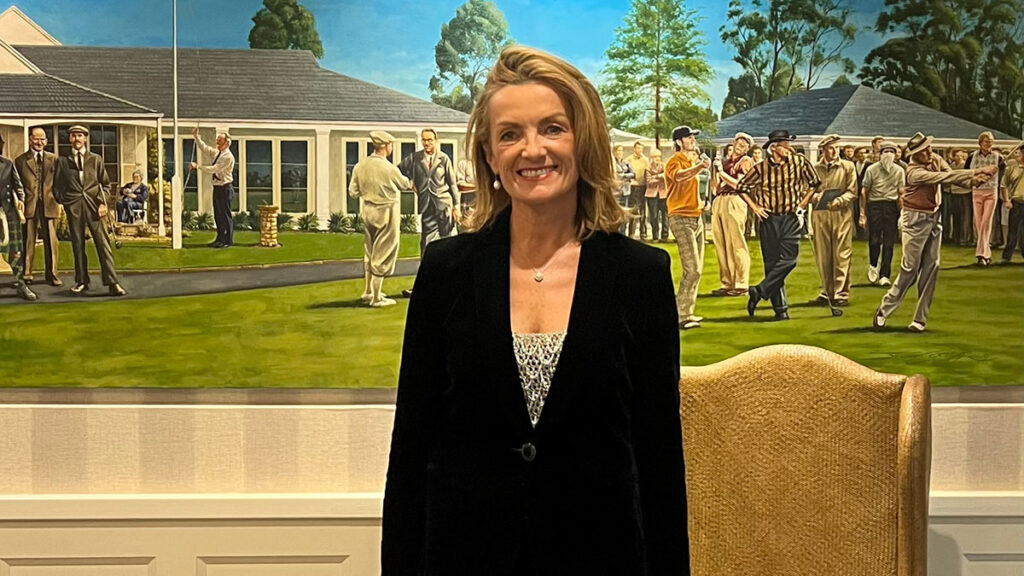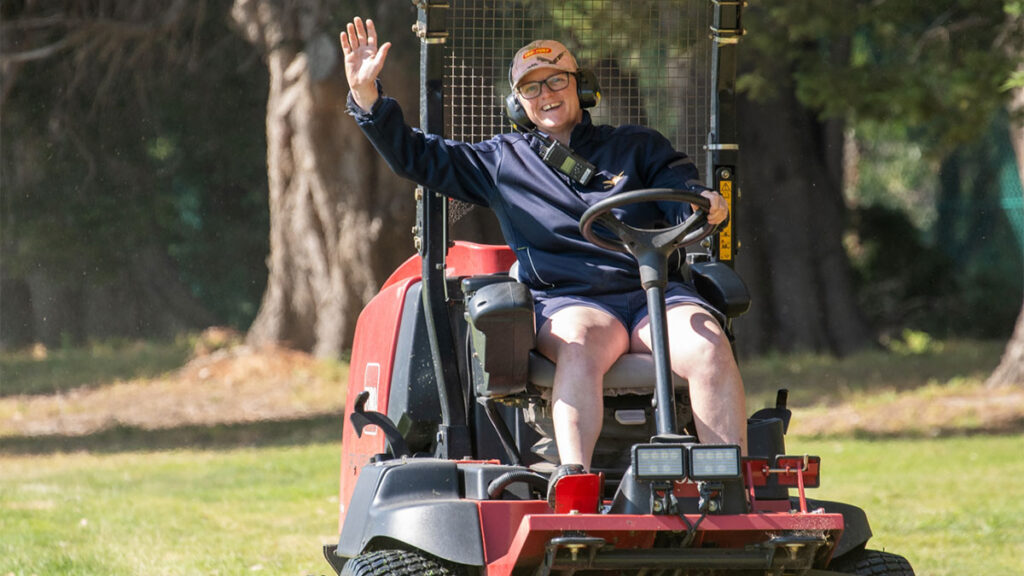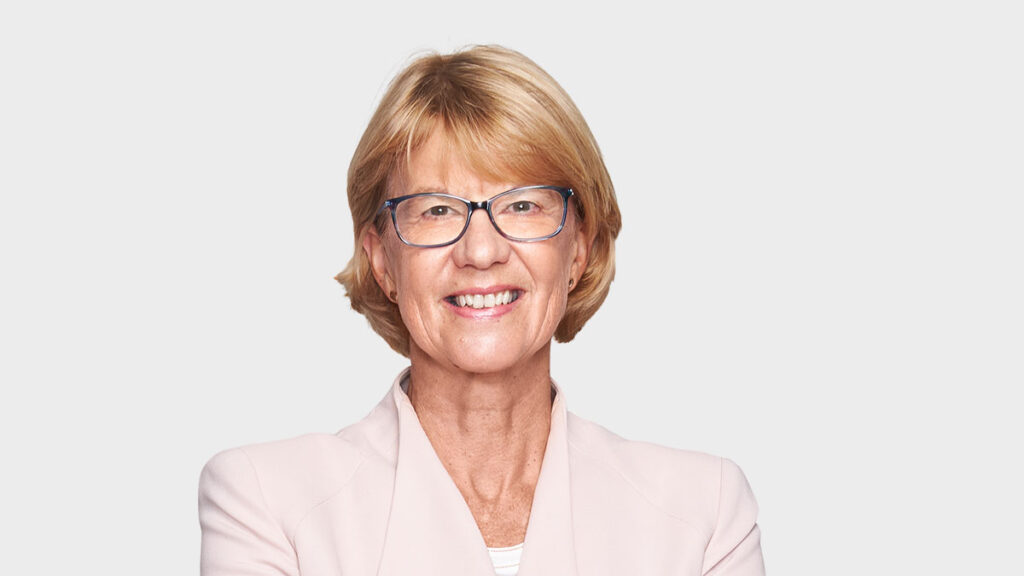These success stories are proof that making a difference in golf is no longer a pipedream for women, young or old.
Golf means different things to different golfers, yet some women choose to dive right in and make more of their involvement within the game than merely playing it. Australian Golf Digest Women spoke with five who have gone beyond the playing realm and taken on an advanced role within golf. They are of varying ages, come from different walks of life, have different backgrounds and vastly differing areas of expertise, yet some of the questions we asked the five were identical. Chief among them was: how do we get more women into golf? As was: what advice would you offer women just starting their golf journey? Their answers were enlightening and struck a harmonious chord.

The right person at the right time: Nikki McClure
President of Kingston Heath GC
The progression of Nikki McClure within the key positions of one of Australia’s elite golf clubs is indicative of the progress that’s possible when it comes to women in golf. Her journey from a newcomer to golf, to becoming the first female president of prestigious Kingston Heath Golf Club in May 2022 is not only inspiring but also a testament to the progress of women in a traditionally male-dominated sport.
McClure’s journey within the game is also heartwarming, as it stemmed from a significant personal tragedy. But more on that shortly, as her story begins in a way familiar to many women in golf.
“It all began when I started golf in my late 30s,” she recalls. “The rest of my family were playing, and I thought, I’ve got to get out there, so I got involved with Kingston Heath. I remember my early days at Kingston Heath, where I was initially overwhelmed by the club’s environment. Over time, my passion for golf and the club grew. I started playing regularly and embracing the game.”
Her involvement expanded as she was invited to join Kingston Heath’s sub-committees, participated in inter-club events and became part of various women’s groups. It was during this journey that the opportunity to become the women’s captain arose in 2018. McClure’s tenure as women’s captain was extended by a year due to the challenges brought on by the COVID-19 pandemic.
“The captaincy opened my eyes to the community and culture within the club,” she says. “It strengthened my passion for the club and highlighted a significant need to increase the women’s demographic. We had an ageing female membership and a lack of young women joining the club.
“I thought, We just need to concentrate on membership, so we made it a club initiative that didn’t just rely on the women’s cohort for retention. Everybody was involved, and I feel like the idea being a club-driven initiative gave it huge importance that has been an outstanding success. During the past four years, we’ve had 80 new female members join the club, dropping the average age by 10 years and increasing representation to 29 percent – comfortably sitting above the national average.”
The key to McClure’s successful leadership in this endeavour was not just her determination but her ability to connect with people. Even though Kingston Heath as a club was right behind the push, such an impressive result led us to ask McClure if it was fair to say that she was the right person at the right time.
“Yes, I believe so,” she replied, before adding, “I think you need to be a certain type of person. You need to be a people person with passion. You need to have EQ over IQ, you need to be able to adapt to all characters and personalities and you need to be a good listener and bring everyone on the journey, then everything else falls into place.
“All the skills you may have created over your lifetime, all the education you’ve had, the experiences you’ve shared, all that just comes to fruition. My mentors and the people around me at The Heath have been so encouraging and supportive, too. They’ve been really important.”
What was also important for McClure was golf’s cathartic effect. In 2003, she lost her 13-week-old daughter, Alana, to Sudden Infant Death Syndrome (SIDS). During the grieving process, it was McClure’s mother, Barbara, who urged her to play golf, which turned out to be a vital step in moving forward.
“It was absolutely cathartic, it provided me an escape from the pain and grief, it allowed me moments of respite from feeling sad constantly, offering a gradual path to healing,” she recalls. “The exercise, the wide green spaces and the simple act of getting out in the fresh air can work wonders for an individual’s wellbeing.”
McClure’s personal journey is a testament to the transformative power of golf. “I’m the perfect example. It’s changed my life,” she says.
While her presidency was a significant milestone, McClure couldn’t help but feel a sense of leadership for others to aspire to: “I’ve always felt that the presidency role is not only an opportunity to give back to my own club but an opportunity to reach out and lead by example in our Australian golf landscape. You cannot be what you cannot see; if I can inspire and empower other women across the country who have ambitions to lead their clubs, then that would be extremely satisfying.
“An opportunity arose for me to collaborate with women who held executive board positions from clubs in Queensland and South Australia. In early 2023, we established the Golf Leaders Network – we launched it during Golf Australia’s Women & Girls engagement month, at the Australian Golf Centre at Sandringham. The newly formed Golf Leaders Network aims to facilitate connections among women in voluntary board executive roles, address shared challenges and develop strategies for improvement. Additionally, the network seeks to encourage and mentor the upcoming generation of golf-club leaders, collaborate with supportive allies and contribute to the implementation of the Australian Golf Strategy. It’s such an exciting space to be working in and we are looking forward to our next conference at the Grange Golf Club in Adelaide in March 2024.”
While McClure stressed the importance of working together to find and support more female chairs or office bearers in golf clubs across the country, her story is not just about golf but about breaking barriers and fostering inclusivity in a sport that has been in need of change for far too long.

The ‘accidental’ course super: Gerri O’Callaghan
Course superintendent at Sandy Golf Links
Gerri O’Callaghan is a sight to behold as she drives a Workman around Sandringham Golf Links with her four-legged companion ‘Ronald’ by her side. O’Callaghan and the golden retriever are a regular presence late into the evening at the new home of Australian high-performance golf, across the road from Royal Melbourne.
In 2021, O’Callaghan was appointed superintendent at Sandringham, becoming what’s believed to be the first female appointed to that role in Victoria. (The only other current female superintendent in Australia is Michelle Huzzey at the nine-hole Wynyard Golf Club in Tasmania.) In that sense, 46-year-old O’Callaghan has become somewhat of a trailblazer in a predominantly male-dominated industry.
“I’m on show with Sandringham now,” O’Callaghan says. “I know a lot of people that play there, and I think, too, because I am the woman. So when you look at the groundkeeping crew, they always pick you out.”
While she is an outstanding golfer – a plus-1 marker with 10 club championships to her name – a career in turf wasn’t on the horizon while growing up in Cohuna and Echuca on the Murray River. Her mother Nancy suffered a fatal heart attack when she was just 19 years of age. Three years later she lost her dad, Gerry. O’Callaghan then spent six years backpacking around the world, working as a water-skiing instructor in Pennsylvania followed by some landscaping and bar work in the UK.
O’Callaghan entered turf maintenance by accident. A hospitality stint at the Henley Rowing Regatta led to an opportunity to mow the carpark and she ended up maintaining the hallowed grounds for five months.
Upon return to Australia in 2007, a chance conversation led to an apprenticeship at Sandhurst Club in Melbourne. At night she completed a Certificate III and then a Diploma in Horticulture Recreational Turf at TAFE.
O’Callaghan was appointed assistant superintendent at Sandringham in 2011 prior to working as a ‘foreman’ on Royal Melbourne’s East course. She was responsible for bunkering at the 2019 Presidents Cup before returning to Sandringham during the reconstruction of the par-65 layout (ranked 58th on Australia’s Top 100 Golf Courses).
It was O’Callaghan’s work ethic and communication skills that earned her the promotion to superintendent at Sandringham. Expectations are high at Melbourne’s best public-access facility, which lures golfers seeking a true Sandbelt experience with a modest green fee of $57.50 ($62.50 on weekends). Maintaining a course averaging 250 rounds a day in mint condition with a crew of eight requires constant application.
Fortunately, O’Callagan’s perseverance is admirable, according to Richard Forsyth, Royal Melbourne’s director of courses.
“It’s hard enough to make your way as a male. But to do it as a female, she would have copped a few knocks along the way. So she has been very resilient,” Forsyth said after her appointment in 2021. “Not all males go well with someone as a woman organising them in a male-dominated industry. So she’s had to deal with all that as she’s gone.”

The business mind: Alison Watkins
Decorated company executive, PGA of Australia board member
Alison Watkins’ introduction to golf was typical… until a point. Her parents were her initial influence from age 8 before her relationship with golf became increasingly pivotal as her business career took off.
“I grew up on a farm in Tasmania and my parents were keen golfers,” she says. “The local golf club was a really important part of the country community. Dad used to cut down his old clubs for us kids and we’d create our own golf courses out in the paddock. Later, he’d let me caddie for him on Saturdays. He always seemed to take my club selection advice seriously and I was sure I was a major contributor to his many wins. I’d get to play a few holes while the men were in the clubhouse enjoying a beer. Dad was a low handicapper and he and some of the other golfers made sure I had a good grounding in the basics along the way.”
Those basics evolved into a lifelong passion but one that became an advantage in the business world. Watkins’ résumé is impressive. A Bachelor of Commerce, her career led her to executive roles with ANZ, Berri, GrainCorp and Coca-Cola Amatil, as well as numerous directorships. She is also a Fellow of the Institute of Chartered Accountants, the Financial Services Institute of Australasia and the AICD. Perhaps most pertinently, she is now a board member of the PGA of Australia.
“Earlier on in my career, golf was often part of doing business,” Watkins says. “Companies would have golf days and senior executives would play golf with clients to build relationships. That excluded a lot of people – including most women – from participating. As a woman in business, I’m very conscious of this and while I’ll occasionally play with business colleagues, I don’t do it with a business purpose.”
A 10-handicapper who is a member of Barwon Heads Golf Club near Geelong and who loves the recent upgrades to the Melbourne Golf Centre at Albert Park, Watkins has rubbed shoulders with some of golf’s elite yet still savours touring out-of-the-way courses like those in Tasmania where she began.
“It’s been awesome to play with amazing professional golfers like Karrie Webb, Mike Clayton and Rodger Davis. But I’ve learnt the most from playing with outstanding amateur golfers like Heather Brodie and Jenny Cardin, who are generous and encouraging members at Barwon Heads. Both have immaculate short games and reminding myself of Heather’s putting routine to ‘Lock, Load and Listen’ is invaluable.
“I love the infinite variety of the game – weather, playing partners, formats, courses and my own form, which I can never take for granted. I particularly love country golf courses – often maintained by committed volunteers with an honesty box for green fees and with a wide range of conditions to navigate, like cracks in the ground, sand-scrape greens and plenty of wildlife, friendly and otherwise.”
But back to that PGA of Australia directorship, and what lies ahead.
“I’m inspired by the focus of the leaders of our peak golf bodies – Gavin Kirkman, James Sutherland and Karen Lunn – on how we keep growing the game overall,” Watkins says. “That includes strong recognition of the need for much greater participation from women and valuing all golf formats, ranging from the occasional game of mini-golf right through to club memberships. The PGA represents our playing and vocational members and is working very closely with the WPGA and Golf Australia. It’s an exciting time in the world of golf and I hope I bring strategic and commercial perspectives to the table as well as a focus on increasing women and girls’ participation.
“As a sport we need to work harder to create opportunities and encouragement for school-age girls to try golf and build some familiarity with the sport. The Australian Golf Foundation, with the support of Bonnie Boezeman, is making inspiring progress on this front. The good news is more and more women are enjoying golf formats like mini-golf, driving ranges and simulators. Golf club members are a relatively small proportion of people who pick up a golf club. I don’t think you need to be a member of a club, however the best clubs will capitalise on this interest in coming years and steadily become a lot more diverse and sustainable.”
A career and business background like Watkins’ leads to one further, perhaps inevitable, question: which aspect of business life has helped most with golf?
“Reminding myself to focus on what I can control!” she says. “In business, plenty happens that you wish hadn’t and that’s certainly true in golf. But you can’t dwell on that missed putt or triple-bogey. Just as in business you have to regroup, stop feeling disgruntled and focus on the opportunities ahead!”

The experienced guide: Stacey Peters
Women & Girls Pathway Manager at Golf Australia, former touring pro
That Stacey Peters won nine times during her career as a tour professional despite not having a golf lesson until she was 18 is as unbelievable as it is remarkable. Yet it’s the truth.
The 2013 Vic Open champion grew up in western Victoria, at first tagging along with her Nan at Lismore Golf Club. Even well into her teens, Peters (who competed under her maiden name of Keating for much of her career) was, by her own admission, far from elite.
“I wouldn’t say golf come easily to me,” she says. “I’d say I was a bit of a ‘chopper’. I didn’t have a golf lesson until I was 18. Very raw, would be a good way to put it. I think I was still off a handicap of 8 when I was 18.”
Peters eventually refined her golf skills, aided perhaps by an upbringing that also included stints playing tennis and hockey within an interest that spanned several sports. She was 17 or 18 before golf became her sole focus, which is late by today’s standards. Yet she still was amply good enough to turn pro by age 24 and craft a seven-year career on the Ladies European Tour, winning twice, while continuing to play in Australia until the 2017-2018 season.
Being raised in a rural area – Peters’ hometown of Cressy is 68 kilometres west of Geelong – also played a part and provides something of a lesson for up-and-coming girls in any sport, which is handy given her current role as Golf Australia’s pathway manager for women and girls.
“Growing up in the country, I was quite resilient. I don’t ever say ‘tough’, but I think my work ethic helped me get where I got to. Maybe that’s growing up on a farm – I’m not sure – but I would say I got the most out of myself because of my work ethic. I wasn’t a world-beater, but I practised very hard.”
While Peters misses the cut-and-thrust of tour life – “I miss the competition; I don’t miss a lot of the other stuff that comes with it, though” – she is revelling in her ‘second career’ as a guide for rising Australian female stars. When Australian Golf Digest Women caught up with Peters at Joondalup Country Club in August, she was deep in conversation with rookie Perth professional Kirsten Rudgeley, who was days away from flying out for the Ladies European Tour. In her next start, Rudgeley missed a playoff
at the Women’s Irish Open by just a shot.
“The competition is just getting stronger and stronger,” Peters says of the difficulty of finding success as a tour pro today. “There are so many more girls at the top level that it’s getting harder and harder.”
Which translates into a need to aim to become the best nation in the game-development space, but that process begins with drawing more girls into golf.
“There’s a big focus on the grassroots area and generally getting more people into golf, no matter what golf it is. Is that at a driving range? Is that on a putting green? Is that putting on the ‘Himalayas’ at Sandy Links? Is that a mini-golf clinic?
“You can go play nine holes – it can be ‘nine and dine’ or nine holes and a champagne – it can be a driving-range session, it can be just putting. And it could be the 18-hole competition if that’s what you’re into, but there are so many different variations. I don’t think other sports have a lot of these options.”
Now having a young daughter, two-year-old Zoe, has given Peters a new perspective on what prevents many women – OK, mothers – from venturing into golf in even a small way.
“It’s the time commitment,” she insists. “That’s why more women aren’t taking up the traditional style of 18 holes and competition golf. Now I’ve got a two-year-old daughter and I’m working part-time, there’s a juggle of everything and family time taking more of a priority than getting a game of golf in. Our time is limited when the three of us get to spend time together, so I prioritise other things more than I have – and I say that as a golf nut. Golf is on my priority list, but it’s not as high as it used to be. I think that’s a common thing. My ‘guilt factor’ of being away from my daughter to go and play golf – that just doesn’t sit well with me.”
Even still, Peters’ advice for other women when it comes to embarking upon their golf journey is very simple: just start. “And start with someone you’re comfortable with, because it can be intimidating and it can be daunting,” she says. “We’ve got 6 percent of coaches in Australia who are women, and while we still have a long way to go, the number is only getting bigger and helping break down the barriers some women may face.”

The natural: Nat Cook
Olympic gold and bronze medallist, motivational speaker, ingrained golfer
We all admire any top-tier sportsperson, yet those who are gifted in more than one sporting discipline receive a heightened level of veneration. Natalie Cook, who, along with Kerri Pottharst, claimed a gold medal for Australia in beach volleyball at the 2000 Olympics in Sydney, comes across as a ‘natural’ sportswoman. Even though beach volleyball is where she excelled, her acumen and athleticism seem to translate well into almost any sport.
Golf, it turns out, is one of them.
At one time as low as a 10-handicapper, golf has been a constant in Cook’s life. She took up the game as a teenager at Brisbane’s Jindalee Golf Club at the encouragement of her dad and never let it go. Now 48 and firmly entrenched in a post-Olympic career as a motivational speaker, athlete advocate and adviser, and sporting ambassador, her life in golf has reached more peaks than many people might realise – partly because she started at an early age.
“They often say lots of sporty people can play golf, but I started when I was young,” Cook says. “I went to the Charlie Earp junior golf clinic on a Sunday for $5 at Royal Queensland, and he basically taught me everything I needed to know. I also learned a lot of etiquette playing with the ladies on a Saturday at Jindalee.
“Golf is definitely unique when it comes to managing emotions, managing frustrations, consistency of swing, to finesse, to power. I just love the challenge. It’s great. Every time I play, I leave saying, ‘How awesome! I want to play more.’”
The corporate golf scene is usually the pathway for Cook to play these days, which often places her in the same group for 18 holes as high-level businesspeople and fellow sports personalities. Even one of her home clubs – Bonville, near Coffs Harbour – recognised her status as an Olympian and bestowed an honorary membership to Cook. Bonville’s owner Peter Montgomery is a four-time Olympian (water polo) and likes to acknowledge golf-playing fellow Olympians in the same fashion. Cook has an ambassadorial membership at Links Hope Island, which is closer to her Brisbane home.
Pro-am opportunities and similar events have given her the chance to play alongside Greg Norman, Adam Scott and Cameron Smith – arguably the three most iconic male Queensland golfers. Karrie Webb, of course, deserves a place in such illustrious company, however, Cook says the lack of coverage of women’s golf on TV in her formative years meant Norman and Michael Jordan became her sporting idols.
“We didn’t see as much of Karrie and female sport on TV as we saw of Greg back then,” says Cook, who is only a month younger than Webb. “We’ve obviously seen the rise now, but Karrie is still our greatest golfer ever. I was born in Townsville; she was born in Ayr. My grandparents were from Ayr and my mum was born in Ayr, so we have a great connection.”
One of the advantages of rubbing shoulders on the fairways with professionals of such high calibre is the advice Cook has gleaned over time. For instance, Scott suggested Cook focus on her rotation during the swing to improve her follow through. Norman, meanwhile, said to ‘always go for it’. “So anytime I consider whether to lay up or play it safe, I always think about Greg Norman.”
More recently, as a guest on the “How Good Is Golf?” TV show, host Paul Gow gave Cook several chipping tips. “That’s the toughest part of my game,” she says. “Without practise, getting the finesse on a chip or half-shot anywhere is difficult. I’m pretty good on full swings, but when it comes to half-a-swing I want to lift my head.”
Yet, even after all that advice, Cook says those original lessons from Earp still resonate most.
Then there are the attributes that translate across sports. Cook says the high-pressure performance skills she gained through volleyball do transfer to the golf course. “It might be a birdie putt and just knowing to breath and staying calm and composed under pressure. That has probably helped me the most. Also having perspective and not getting too frustrated.”
A different brand of perspective has come through the people Cook has encountered on the golf course, as well as her own experiences. She feels the biggest challenge for women and golf is finding time to play. The solution is to create a window of time that fits.
“Females tend to run the house and run the kids, so it becomes difficult to allocate the time, but golf is a perfect game from 9 ’till 2 – after dropping the kids at school until picking them up,” she says. “The best gift you can give yourself as a female – if you are in charge of kids in the family home – is to play golf once a week while the kids are at school. And if you’re a corporate or a CEO, then the outdoors – that space for your brain to have a rest to focus on something else – is really good.”
Earlier this year, Cook started a group called AWE (Active Women Executives), which is a monthly gathering of C-suite women. “We play golf 1-2 times a year, as I rotate sports each month,” she says. Through that initiative, Cook sees yet another way women can become drawn to the game.
“I’ve found that I’m most successful when inviting other women to come and have a go for two hours at a driving range with a coach, so they can feel like they’re getting better. Women like to feel like they’re improving – they don’t like to go on a course and feel like they’re getting worse, which can often happen in golf. So, education, smaller time chunks, having a PGA professional and surrounding yourself with other women that they want to spend time with – it’s all those reasons.
“It’s going to take a while to get to a critical mass. It’s going to take a lot of effort, like pushing the cart uphill. We’ve got to get some high-profile women CEOs or high-profile women playing and inviting others. That’s where women’s golf can do better. I think the sport can do better on educating about the benefits and through encouragement. Most women do not want to play or participate in a sport if they’re not good at it. Otherwise they feel embarrassed; they feel like they must be at a certain level before they can have a go, but obviously you’ve got to practise to get to that level and commit time on the practice range. You might have to see a golf coach or PGA pro to get you to that level.
“So start slow – even just a coaching session and three holes. Eighteen holes is difficult if you’re not already a golfer, so start small and then grow it. And find one or two others you’re going to play with that keep you accountable and keep going, because it’s very easy to say, ‘I’ll go next week, I’ll go next week,’ and, ‘I’ll go next week.’ Because before you know it, it’s been a year.”

